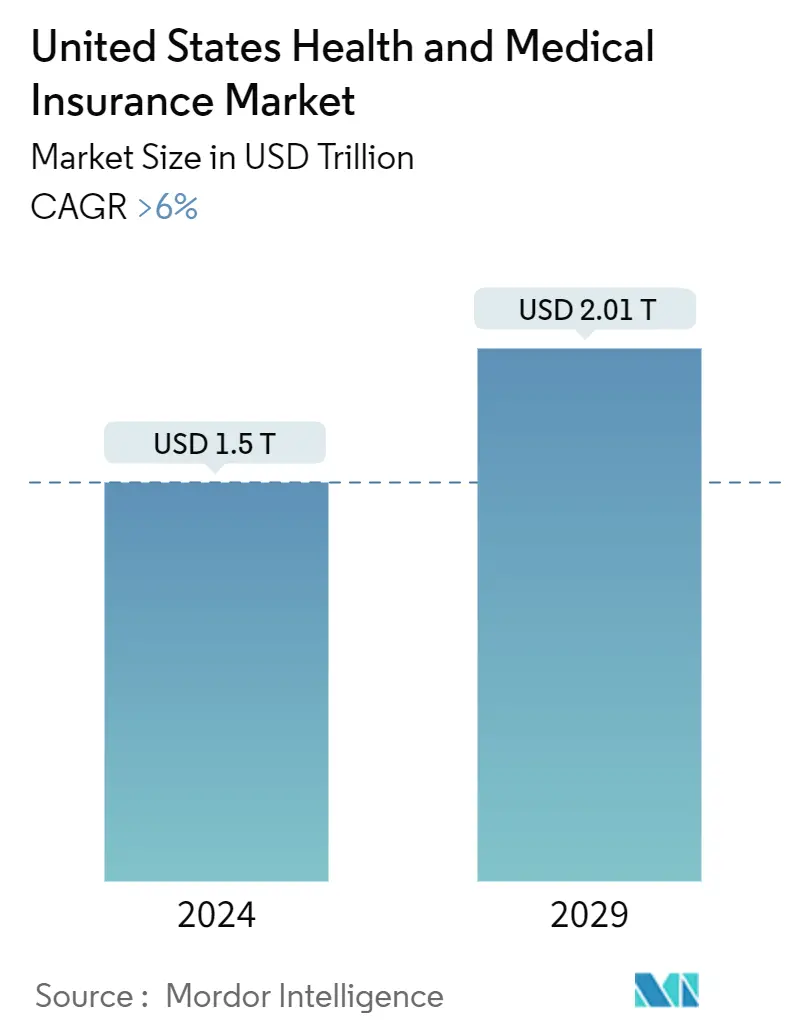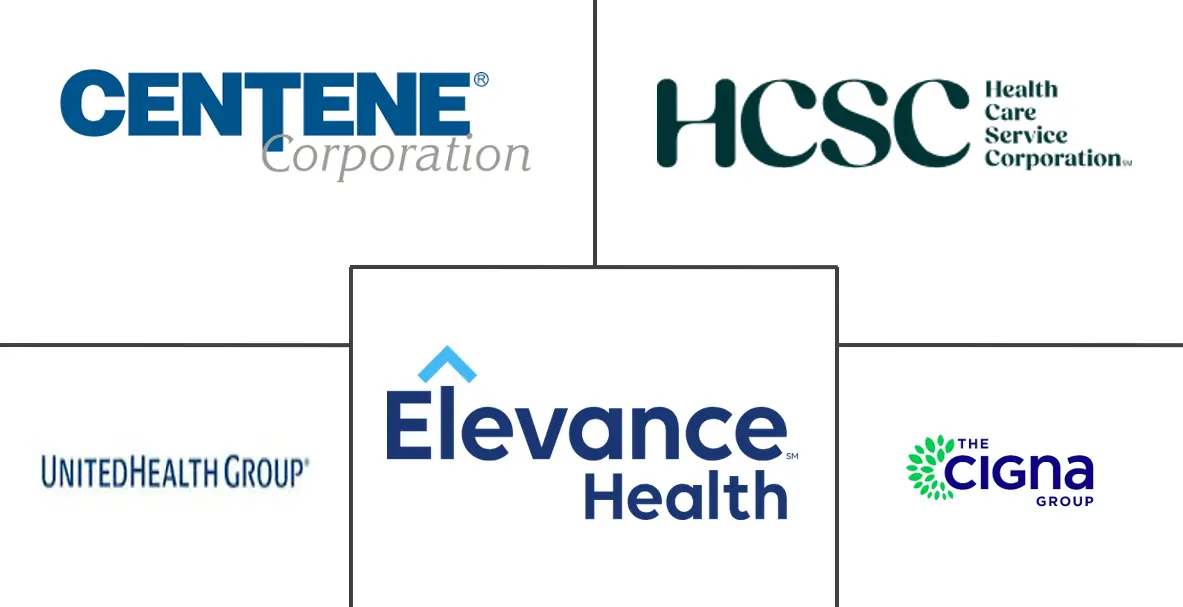Market Size of United States Health And Medical Insurance Industry

| Study Period | 2020 - 2029 |
| Base Year For Estimation | 2023 |
| Market Size (2024) | USD 1.5 Trillion |
| Market Size (2029) | USD 2.01 Trillion |
| CAGR (2024 - 2029) | 6.00 % |
| Market Concentration | High |
Major Players
*Disclaimer: Major Players sorted in no particular order |
United States Health And Medical Insurance Market Analysis
The United States Health And Medical Insurance Market size is estimated at USD 1.5 trillion in 2024, and is expected to reach USD 2.01 trillion by 2029, growing at a CAGR of greater than 6% during the forecast period (2024-2029).
The US healthcare system is characterized by high costs for individuals and the lack of universal coverage. The government takes steps to assist economically disadvantaged groups, such as the elderly, disabled, and underprivileged individuals, with healthcare expenses. Due to the absence of a nationwide health insurance system, most Americans rely on their employers for health insurance coverage, either through the employer's plan or by purchasing individual plans directly from insurers. In the market, private health insurance providers compete with each other to provide individuals and families with a variety of healthcare options.
Health insurance provided by employers is an important role to play in the provision of health care, as there are many employers offering healthcare benefits under their workers' compensation packages. This model allows for the sharing of premium costs between employers and employees, often through negotiated group rates with insurance companies. The individual health insurance market serves those without access to employer-sponsored plans or government programs like Medicare and Medicaid, offering plans through the Health Insurance Marketplace established by the Affordable Care Act, as well as directly from insurance companies.
The United States government participates in the health insurance sector through initiatives like Medicare, Medicaid, and the Children's Health Insurance Program (CHIP). Medicare is mainly for individuals aged 65 years and above, while Medicaid and CHIP cater to low-income individuals and families. The Health Insurance Marketplace, also known as the Exchange, is an online application or platform where people can compare and buy health insurance plans from private insurers. These plans are grouped into metal levels (Bronze, Silver, Gold, and Platinum) based on coverage and cost-sharing. The US health insurance market post-COVID is experiencing a surge in demand and evolving coverage options.
In addition, the rising incidences of chronic diseases like diabetes, cancer, heart diseases, and neurodegenerative conditions are expected to boost the uptake of health insurance. The costs linked to treating chronic illnesses such as cancer and heart disease are notably high in the United States. As a result, many individuals opt for health and medical insurance to avoid the sudden financial strain of hefty hospital bills and other medical expenses.
United States Health And Medical Insurance Industry Segmentation
Health insurance is a type of insurance that covers medical expenses that arise due to an illness. A complete background analysis of the US Health Insurance industry, including an assessment of the national health accounts, economy, and emerging market trends by segments, significant changes in market dynamics, and market overview, is covered in the report. The market is segmented by procurement type, products and services, and place of purchase. By procurement type, the market is segmented as directly purchased and employer-sponsored. By products and services, the market is segmented into pharmacy benefit management, high-deductible health plans, free-for-service plans, and managed care plans. By place of purchase, the market is segmented as on exchange and off exchange. The report offers market size forecasts for the US health insurance market in terms of revenue (USD) for all the above segments.
| By Procurement Type | ||||
| Directly/individually Purchased | ||||
|
| By Products and Services Offered | |
| Pharmacy Benefit Management | |
| High Deductible Health Plans | |
| Free-For-Service Plans | |
| Managed Care Plans |
| By Place of Purchase | |
| On Exchange | |
| Off Exchange |
United States Health And Medical Insurance Market Size Summary
The United States health insurance market is characterized by its reliance on employer-sponsored plans and individual purchases, given the absence of a universal coverage system. The market is moderately consolidated, with major players like UnitedHealth Group, Elevance Health, Cigna Group, HCSC Group, and Centene Corporation competing to offer a variety of health insurance options. The government's role is significant through programs like Medicare, Medicaid, and CHIP, which cater to specific demographics such as the elderly and low-income families. The Health Insurance Marketplace, established by the Affordable Care Act, provides a platform for individuals to compare and purchase insurance plans. The market is witnessing growth driven by the increasing incidence of chronic diseases, which necessitate health insurance to mitigate the financial burden of high medical costs.
The market is also experiencing a shift towards digitalization, with the online channel segment expected to expand rapidly. This growth is fueled by the convenience of online purchases, technological advancements, and changing consumer behaviors. Insurers are leveraging technologies like artificial intelligence and machine learning to enhance data analysis, risk management, and medical billing processes. Private health insurance plans offer a range of benefits, including hospitalization, outpatient care, and mental health services, with coverage and cost-sharing varying by plan. Despite the high costs associated with private insurance, the demand is expected to rise as more individuals seek to avoid the financial strain of healthcare expenses. The competitive landscape is further shaped by strategic expansions, mergers, and acquisitions, as companies aim to strengthen their market position and enhance their service offerings.
United States Health And Medical Insurance Market Size - Table of Contents
-
1. MARKET DYNAMICS
-
1.1 Market Overview
-
1.2 Market Drivers
-
1.2.1 Government Subsidized Health Insurance Schemes is Boosting the Sales of Health and Medical Insurance Policies
-
1.2.2 Aging Population in United States and increasing Healthcare Costs
-
-
1.3 Market Restraints
-
1.3.1 Rising Costs and Limited Coverage
-
1.3.2 Increasing Regulatory complexity
-
-
1.4 Market Opportunities
-
1.4.1 Innovative Digital Health Solutions
-
1.4.2 Merger and Acquisition with the Companies
-
-
1.5 Porter's Five Forces Analysis
-
1.5.1 Threat of New Entrants
-
1.5.2 Bargaining Power of Buyers/Consumers
-
1.5.3 Bargaining Power of Suppliers
-
1.5.4 Threat of Substitute Products
-
1.5.5 Intensity of Competitive Rivalry
-
-
1.6 Government Regulations and Initiatives
-
1.6.1 Brief on Patient Protection and Affordable Care Act (ACA) and its implications on the Overall Health Insurance Coverage
-
1.6.2 Insights on Latest Healthcare Policy Changes and their Effect on the Health Spending by US Citizens
-
-
1.7 Brief on Health Insurance Premiums and Study on the Effect of Medical Trend Rate on Health Plans
-
1.8 Insights on the Growing Online Sales of Health Insurance and the Growth Prospects in Health Insurance Sector
-
1.9 Technological Advancement and Innovation in Health Insurance Sector
-
1.10 The Impact of the COVID-19 Pandemic on the US health Insurance market
-
-
2. MARKET SEGMENTATION
-
2.1 By Procurement Type
-
2.1.1 Directly/individually Purchased
-
2.1.2 Employer-Based
-
2.1.2.1 Small Group Market
-
2.1.2.2 Large Group Market
-
-
-
2.2 By Products and Services Offered
-
2.2.1 Pharmacy Benefit Management
-
2.2.2 High Deductible Health Plans
-
2.2.3 Free-For-Service Plans
-
2.2.4 Managed Care Plans
-
-
2.3 By Place of Purchase
-
2.3.1 On Exchange
-
2.3.2 Off Exchange
-
-
United States Health And Medical Insurance Market Size FAQs
How big is the United States Health And Medical Insurance Market?
The United States Health And Medical Insurance Market size is expected to reach USD 1.5 trillion in 2024 and grow at a CAGR of greater than 6% to reach USD 2.01 trillion by 2029.
What is the current United States Health And Medical Insurance Market size?
In 2024, the United States Health And Medical Insurance Market size is expected to reach USD 1.5 trillion.

